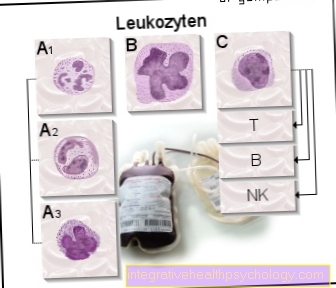Symptoms of polyneuropathy
Symptoms

In the vast majority of cases, the following symptoms occur, beginning distally on the lower extremities:
- Pain
- Sensory disturbances, disturbances of the sense of touch (sensory disturbances), nocturnal discomfort in the area of the toes or soles of the feet
- Unpleasant temperature sensation
- Excruciating tingling sensations or pins and needles
- Burning of the feet, especially the soles of the feet ("burning feet“)
- Stocking or glove-shaped sensitivity deficits ("walking like socks")
- Decreased or absent sense of vibration
- Lack of Achilles tendon reflex
- Paralysis of the muscles on the back of the foot, so that the toes can no longer be spread and the tip of the foot gets stuck while walking
- Later, additional sensitivity disorders and paralysis in the hands and arms (upper extremities)
- Brief loss of consciousness (syncope) and bladder disorders
- Dizziness, unsteady gait
- Disorders of the cranial nerves
When the symptoms appear, there are symmetrical and asymmetrical distribution patterns, some of which suggest the cause of the polyneuropathy.
Symmetrical: Most common type with glove- and stocking-shaped sensory disturbances and distal reflex weakening and / or paralysis.
Asymmetrical: There are three different types:
- In the case of mononeuropathy, only disorders in the supply area of a peripheral nerve can be recognized.
- In mononeuropathy (Mononeuritis) multiplex (Multiplex type) disturbances can be seen in the supply areas of several peripheral nerves, but the neighboring nerves are hardly or not at all impaired.
- The main neuropathy is a combination of mononeuropathia multiplex and a symmetrical polyneuropathy.
Symptoms on the feet
Often the feet and the legs are where a polyneuropathy first becomes symptomatic.
Polyneuropathy becomes noticeable very early, especially on the toes. In addition to the possible symptoms already listed, such as abnormal sensations in the form of tingling or numbness, an unsteady gait and dizziness are typical for a polyneuropathy of the feet.
Also read our article about Burning toes and feet
This occurs particularly in the dark and can be explained by the fact that, in addition to the sense of balance, seeing and perceiving the position of the extremities in space, the so-called proprioception, play a role in the balance system.
Proprioception is mediated by the nerves in the extremities, which provide the brain with information about the position of the arms and legs.
In polyneuropathy, precisely those nerves are often damaged, which means that this component of the equilibrium only functions to a limited extent or even no longer functions at all. If the visual system is then switched off by darkness, the equilibrium system can no longer function properly, resulting in dizziness and unsteady gait, which can manifest itself in falls.
Another symptom that can be characteristic of the polyneuropathy of the feet is the so-called allodynia, i.e. a pain reaction to a stimulus that is perceived as not painful by healthy people. For example, just putting on socks or shoes can lead to severe pain.
You can also read our topic here: Pain in the feet
In contrast to this, the nerves of the feet can also be damaged by the polyneuropathy in such a way that they detect stimuli less well and thus the stimulus perception is qualitatively reduced or only possible with a delay.
Therefore, temperatures or injuries that trigger pain as a warning signal in healthy people are delayed or not noticed at all. As a result, the protective reflexes that are physiologically triggered by pain cannot take place, which can lead to serious injuries that may not be noticed until very late.
This symptom often occurs in polyneuropathy caused by diabetes mellitus, which is why there are typical “diabetic feet” that are seriously damaged by unnoticed injuries and inflammation and sometimes even have to be amputated.
Also typical of diabetic polyneuropathy of the feet is a burning pain on the sole of the foot, which is called "burning feet" referred to as. These abnormal sensations usually worsen at night.Damage to motor nerves, which are actually responsible for their movement by stimulating the muscles in the feet and legs, can lead to weakness of the feet, rapid muscular fatigue and a decrease in strength. This can even be recorded objectively if the muscles are broken down due to reduced excitation (atrophy) and the affected person gets very thin legs.
Another objective method of detecting polyneuropathy is the failure of specific reflexes on the foot.
Symptoms on the hands
In the order of the symptoms occurring in polyneuropathy, the hands are usually affected only after the feet.
Here, the nerve damage, analogous to the damage pattern on the feet, usually first becomes symptomatic in the fingers. In addition to general symptoms of paresthesia, polyneuropathy of the hands can lead to impaired fine motor skills and coordination.
If the polyneuropathy is caused by diabetes mellitus, sensitivity disorders typically occur in the form of a glove.
Read on this topic too: Numbness in the hand.
Symptoms from alcohol
Will be a Polyneuropathy due to alcohol typically causes symptoms to develop very slowly.
These are typically symmetrical and manifest themselves particularly on the feet and legs.
This often leads to disturbances in sensitivity in the affected areas, which can, however, vary from person to person. So can the Vibration sensation be affected, but also the temperature- or the Sensation of pain.
Often there are pains that have a burning character, most of which are in the feet (burning feet) or the calves are affected (sie Oben). The deep sensitivity is very often disturbed in these patients. Then, for example, it is no longer possible to precisely detect when the foot touches the ground while running, as a result of which it is often abruptly touched. This changes the patient's gait objectively.
In the polyneuropathy caused by alcohol Motor nerves are often also affected, which can lead to muscle weakness and even coordination disorders. This type of polyneuropathy often affects a specific motor nerve called the peroneal nerve, located in the lower leg.
The function of the intact nerve is the motor supply of part of the muscles of the foot. If it is damaged, the toes or even the entire foot can no longer be pulled in the direction of the nose and the foot can no longer be adequately lifted when walking.
This in turn leads to abnormalities when walking, since the lack of elevation of the foot due to increased bending of knee and hip What is called a stepper step is compensated.
The involvement of motor nerves often leads to muscle breakdown in affected areas (atrophy), which makes the calves appear thin. If the polyneuropathy caused by alcohol is particularly severe, even the Eye muscles affected or the pupils paralyzed which can lead to symptoms such as double vision. The polyneuropathy caused by alcohol can therefore have a very mild course in which there are only minor sensitive paresthesia in the feet. However, it can also become symptomatic in severe courses in which the quality of life can be severely restricted by coordination disorders and pain.
Symptoms after chemotherapy
A Polyneuropathy can also be used as undesirable effects after chemotherapy occur.
It is characteristic of this that the sensory nerves are predominantly affected and only very rarely those that are responsible for motor skills. Typical symptoms of polyneuropathy after chemo are Feet or hands numbwhich are often indicated as stocking or glove-shaped.
Changed perceptions of pain are also possible, which can be perceived in a weakened but also intensified manner. The nerve damage after chemotherapy also occurs mostly symmetrically and increases. This means that the areas furthest away from the spine are affected by the symptoms first, such as the fingertips, whereby the symptoms can also spread to neighboring regions, for example the arm, over time.
The so-called cranial nerves can also be affected, which can manifest itself in reduced sensory perceptions such as poor hearing or vision. So-called autonomic nerve fibers are more rarely affected by a polyneuropathy after chemotherapy, which is actually responsible for the unconscious regulation of body functions such as digestion are responsible.
Symptoms of damage to these nerves by chemo can be, for example Constipation be. In summary, any kind of abnormal sensation that can be perceived after chemotherapy should be an alarm signal for a possible polyneuropathy.


.jpg)


























